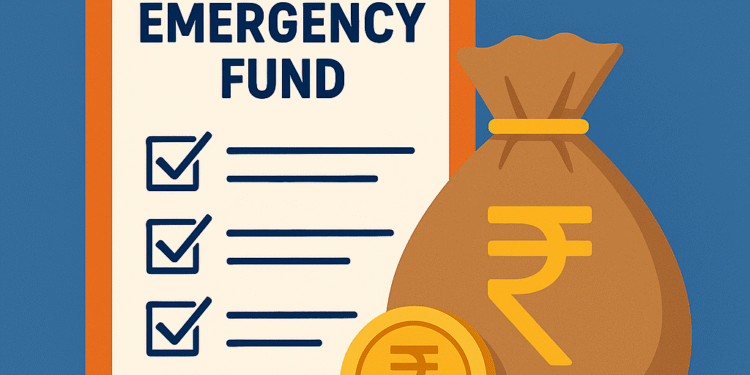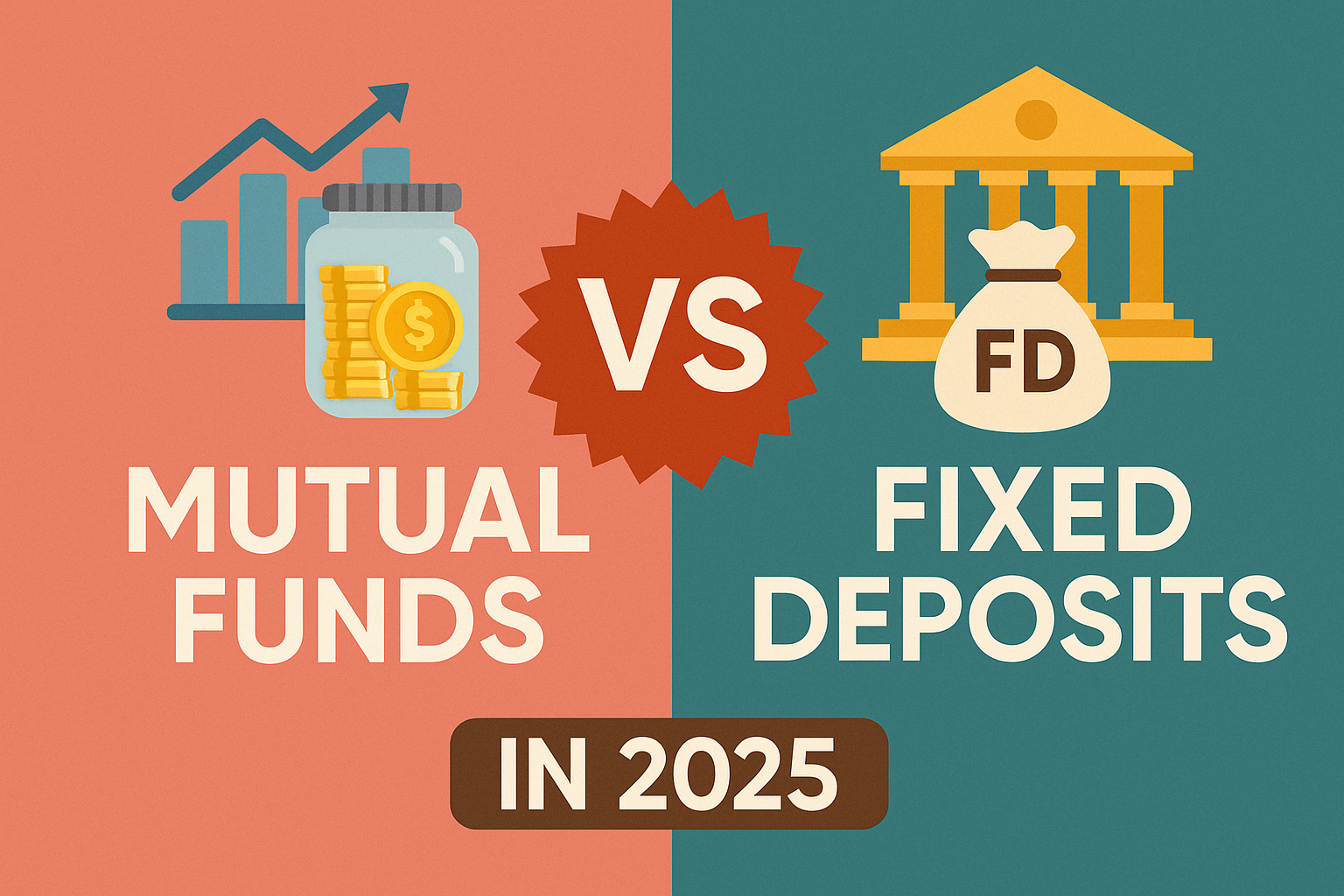This section shows a simple promise: we’ll walk you through setting aside a practical safety net that helps avoid high-interest loans and keeps long-term goals on track when life throws surprises.
An emergency fund is a separate cash buffer you build slowly. It is meant for genuine emergencies like medical bills, job loss, or urgent repairs. Keep it liquid and separate from daily spending accounts.
Start small — even ₹2,000–₹5,000 per month — and automate transfers into a dedicated savings account or low-risk options such as high-interest savings, FDs, or liquid mutual funds.
Use the simple target formula: Monthly Expenses × 6 as a guide. Review the corpus yearly for inflation or lifestyle changes and replenish promptly after any withdrawal. Build this foundation before risky investments so you won’t sell assets at the wrong time.

Key Takeaways
- Set aside a separate account as a steady safety net against unexpected life costs.
- Aim for about six months of essentials using Monthly Expenses × 6 as a formula.
- Park money in liquid, low-risk places: savings account, FDs, or liquid funds.
- Automate small monthly contributions and treat them as a priority.
- Review yearly and replenish after any withdrawal to keep the cushion intact.
What is an emergency fund and why it matters in India today
Think of a separate pool of ready cash that shields your family when a sudden bill or job shock arrives. This safety net sits apart from daily accounts and covers true crises like medical emergencies, sudden loss of income, or urgent home and vehicle repairs.
“A ready reserve stops one bad month from becoming years of costly loans.”
Use it only for real emergencies. That means health bills, essential repairs, or an unexpected job loss. Avoid dipping in for vacations, gadgets, or planned upgrades that can be budgeted.
Insurance helps, but it may not cover income gaps or non‑claimable expenses. A modest financial cushion preserves monthly cash flow and prevents forced selling of investments at a loss.
- Protects monthly expenses and daily stability.
- Reduces reliance on high‑interest loans and credit.
- Gives emotional calm so you can solve the problem, not scramble for money.
Next step: we will quantify the right target and pick a safe, liquid place to park these savings so you have quick access when life surprises you.
Present-day money realities in India: Inflation, rising healthcare costs, and layoffs
Rising prices, steep hospital bills, and sudden layoffs are reshaping household risk today. Everyday costs climb with inflation, and even a short hospital stay can wipe out a month or more of earnings. Surveys show only a minority of adults hold a ready cushion, leaving many exposed.

Healthcare bills are rising: Why medical shocks need instant liquidity
Hospitals often ask for deposits up front. That means quick access to cash matters for treatment choices. Without a small emergency fund, families may use high-interest credit or sell investments at a loss.
Job market uncertainty and household resilience
Layoffs and pay cuts hit across industries. Single-income homes face a longer runway need after an income loss.
- Inflation pushes regular expenses higher each month.
- Non-medical shocks—urgent repairs after storms or accidents—also demand cash.
- Starting small and building emergency capacity steadily improves resilience.
| Risk | Typical impact | Quick response |
|---|---|---|
| Hospitalisation | Large upfront bills | Immediate liquid fund |
| Job loss | Loss of monthly income | 3–6 months runway |
| Home/vehicle repairs | Unexpected repair costs | Small reserved savings |
“A ready buffer keeps decisions focused on recovery, not repayment.”
Next step: quantify your exposure and begin building emergency cover month by month.
Step-by-step guide to building your emergency fund in India
Begin by totaling your core monthly bills so you know the exact amount to aim for. List rent, groceries, utilities, transport, EMIs, school fees, insurance premiums, and routine medical costs as your baseline expenses.
Decide the right corpus
Aim for three to six months of essentials as a starting rule. Dual-income homes may target three months; single-income or unstable-income households should lean toward six months or more.
Pinpoint the target and timeline
Use the simple formula: Monthly Essential Expenses × six months for a robust number. Divide that target by your chosen timeline (12–18 months) to find a realistic monthly contribution.
Choose safe parking and automate
Open a separate savings account and split holdings across a high-interest savings account, an FD ladder, and a liquid/debt mutual fund for balanced access.
| Option | Access | Pros |
|---|---|---|
| Savings account | Instant | Easy withdrawals; keep a separate account |
| Fixed deposits | Partial | Higher interest; use short-term ladder |
| Liquid mutual funds | Same-day | Moderate returns; quick redemptions |
- Automate transfers via standing instructions or SIPs on salary day.
- Prioritise this cushion before higher-risk goals and investments.
- Review annually and replenish promptly after any withdrawal.
“Treat this buffer as non-negotiable until your target is built.”
Emergency fund calculator: Formula, examples, and free tools
Turn your essential monthly costs into a clear target using one easy calculation.
The simple formula
Emergency Fund Target = Monthly Essential Expenses × 6 as a base. Increase the multiplier to 9–12 months if you are a sole earner or face irregular income.

Illustrative example
If core essentials add up to ₹50,000 per month, six months worth equals ₹3,00,000.
For a single-income home, aim for 10–12 months: roughly ₹5,00,000–₹6,00,000 to cover a longer income gap.
Free tools and next steps
Use free online calculators: enter your monthly essentials and pick a months multiplier. The tool outputs a goal and a monthly build amount.
| Input | Multiplier | Target |
|---|---|---|
| Monthly essentials (₹) | 6 months | ₹50,000 × 6 = ₹3,00,000 |
| Single-income risk | 10 months | ₹50,000 × 10 = ₹5,00,000 |
| Build plan | 12 months | Target ÷ 12 = monthly contribution |
- Include rent, groceries, utilities, transport, EMIs, school fees, and basic medical in expenses.
- Add one extra month if you have large annual bills.
- Tag the account clearly and automate transfers to avoid loans after a loss of income.
“A clear target makes steady saving simple and prevents costly borrowing.”
Where to keep your emergency fund in India
Where you keep savings matters: prioritize easy access, low risk, and clear tracking. That way cash is ready for medical bills, repairs, or lost income without market swings.
High-interest savings accounts for instant access
High-interest savings accounts offer immediate withdrawals and zero market risk. Use a separate account and tag it clearly so family members can find it when needed.
Fixed deposits: stability with partial liquidity
Short-tenure fixed deposits add stability and slightly higher yields. Consider an FD ladder so portions mature at staggered dates for access while earning better rates.
Liquid or debt mutual funds for moderate returns
Liquid and ultra-short debt mutual funds aim for modest gains and same‑day or next‑day redemption. They suit tranches you won’t need the same hour but want better returns than a savings account.
Avoid risky or locked-in assets
Steer clear of equities, crypto, PPF, NPS, or long lock-ins for this pool. Those options can be volatile or inaccessible when expenses spike.
“Keep access first, stability second, and yield third for a practical safety stash.”
| Option | Access | Best use |
|---|---|---|
| High‑interest savings account | Instant | Immediate withdrawals and daily tracking |
| Short‑term fixed deposits | Partial (maturity) | Stability and higher interest via laddering |
| Liquid / ultra‑short debt funds | Same/next day | Moderate returns for funds not needed the same day |
- Split the corpus: keep 30–50% in a savings account, rest in FDs and liquid funds.
- Use multiple banks if deposits exceed insurance limits (DICGC covers up to ₹5 lakh per depositor).
- Keep a small cash buffer at home for short digital outages.
Set, automate, and track your monthly savings target
Set a clear monthly target and let automation handle the heavy lifting so saving happens before spending. Treat this as a steady habit rather than a one-off task.

Standing instructions from your salary account move money into a separate account the moment pay arrives. That turns intent into action and prevents impulse spending.
Standing instructions, RDs, and SIPs to build discipline
Recurring deposits (RDs) lock in a fixed monthly deposit. They work well for savers who prefer certainty.
SIPs into low‑volatility mutual funds give modest returns and easy redemptions. Use them for portions you won’t need the same day.
“Automate transfers, then watch small amounts compound into meaningful coverage.”
- Turn intent into action: set a standing instruction on payday from your primary account to your emergency savings account.
- Use the right tools: RDs for fixed habit; SIPs into liquid or ultra‑short debt mutual funds for slightly higher yields.
- Make it visible: track progress in your bank app or a simple spreadsheet to stay motivated.
- Adjust with life changes: raise contributions after a salary bump or reduce briefly during tight months while keeping the habit alive.
| Tool | Access | Best use |
|---|---|---|
| Standing instruction | Instant deposit into savings account | Beat impulsive spending; core automation |
| Recurring deposit (RD) | Locked monthly contributions, premature withdrawal with penalty | Disciplined saving with fixed returns |
| SIP into liquid/ultra‑short mutual funds | Same/next‑day redemption | Modest returns with quick access |
| Bank sweep or multi‑instrument split | Partial instant access; linked FDs | Balance yield and liquidity |
Review quarterly and reallocate bonuses or tax refunds into this pool. Let family members know where the account sits and when withdrawals are permitted.
Prioritize, review, and replenish for inflation and lifestyle changes
Before you move money into higher‑risk assets, finish building a robust safety cushion. That protects months of living expenses when markets fall or income pauses. Treat this pool as your top short‑term goal.
Build the fund before investing in high-risk assets
Make order matter: complete the safety target first, then shift spare savings toward growth goals. This reduces the chance you must sell volatile holdings at a loss during a crisis.
Top-up annually and after any withdrawal
Index your target to inflation. Rising prices and new EMIs quietly shrink coverage in months, so add a yearly top‑up to restore the original amount.
If you use the pool, refill it quickly. Increase monthly contributions for a few months or route bonuses and tax refunds into fund savings until the target is reached again.
“Replenish promptly and review often—small, steady top‑ups build real resilience.”
- Set the order: finish the safety cushion, then invest in higher-risk goals.
- Reflect lifestyle shifts: revisit target when income or expenses change.
- Keep it separate: use distinct savings accounts and labeled instruments.
- Coordinate with insurance: update health and term coverage as responsibilities grow.
- Quarterly check-ins: track months of coverage and adjust contributions as needed.
how to create emergency fund India emergency fund calculator financial planning
Start simple: total your essential monthly expenses, choose a months target (3–6 is typical; more if you are the sole earner), then set a clear monthly contribution that reaches that goal in a realistic timeline.

Pick safe homes for savings: keep a high‑interest savings account for instant access, use short FDs with DICGC cover for part of the corpus, and place another tranche in liquid or ultra‑short debt funds for modest returns and low volatility.
- Automate transfers on payday with a standing instruction and label the destination account clearly.
- Define what counts as an emergency and who can access the money during stress.
- Keep health and term insurance current so the corpus faces fewer large hits.
“A steady habit beats a large, late push—small monthly deposits build real resilience.”
Review yearly and top up after any withdrawal. With this blueprint in place, broader savings and long-term goals stay calm and protected when life surprises you.
Conclusion
A practical cash buffer keeps choices clear and prevents costly borrowing. Quantify your target—start with at least three to six months of essential expenses and raise it if your income is irregular or you are the sole earner.
Park the corpus in liquid, low‑risk places: a high‑interest savings account, short fixed deposits with DICGC cover, and ultra‑short or liquid debt options for modest upside and quick access.
Automate contributions with a standing instruction so the habit runs without willpower. Use the pool only for genuine medical emergencies or sudden job loss and refill it promptly after any withdrawal.
Review the plan annually, protect the purpose from risky investments, and document who may access the account. Calculate your number, open or label a dedicated account, set an automated deposit, and start—small steps build lasting stability.
FAQ
What is a cash safety net and why does it matter now?
A cash safety net is money set aside for sudden needs like medical bills, job loss, or urgent repairs. It protects monthly cash flow, helps you avoid high-interest loans such as credit card debt or personal loans, and keeps long-term goals like retirement and education on track.
How much should I aim to set aside for a basic cushion?
Aim for three to six months of essential living expenses—rent, groceries, utilities, EMIs, and school fees. If you are the only earner or have irregular income, consider extending the target to nine or 12 months for extra stability.
What counts as essential monthly expenses when calculating the target?
Include unavoidable costs: rent or mortgage, food, utilities, transport, insurance premiums, loan EMIs, and any recurring child or eldercare costs. Exclude discretionary spending like dining out, subscriptions, and vacations.
Which places in India offer easy access with decent returns?
Start with high-interest savings accounts for instant access. Fixed deposits offer stability and slightly higher interest; choose FDs with partial liquidity or short tenors. Liquid or ultra-short-term debt mutual funds give modest returns and quick redemptions.
Are there options I should avoid for this purpose?
Yes. Avoid placing your cushion in volatile assets such as equity shares, cryptocurrencies, or long lock-in products like certain tax-saving instruments. These can erode principal or be hard to access during urgent needs.
Can I use recurring deposits or SIPs to build the cushion?
Absolutely. Standing instructions, recurring deposits (RDs), and systematic investment plans (SIPs) in liquid funds help build discipline. Automating monthly transfers ensures steady progress without relying on willpower alone.
What if I need to withdraw—when is it appropriate?
Withdraw only for true financial shocks: unexpected medical treatment, sudden unemployment, major home or car repair, or urgent family obligations. Avoid tapping the pool for wants or market-driven investment moves.
How often should I review and top up this safety net?
Review at least once a year or after major life events like a new child, job change, or rise in living costs. Replenish any withdrawal quickly and increase the target to offset inflation or added responsibilities.
Is insurance a substitute for this reserve?
No. Insurance—health, life, or asset cover—complements the reserve by handling larger, defined risks. The cash cushion covers immediate liquidity needs such as deductibles, temporary income loss, and quick repairs while claims process.
How can I estimate the exact amount I need today?
Use the simple formula: monthly essential expenses multiplied by your chosen months of cover (three, six, nine, etc.). Many banks and wealth platforms in India offer free calculators and budget tools to pinpoint the target using real expense inputs.
What tax or interest considerations should I know about?
Interest on savings accounts and short-term FDs is taxable as per your slab rate and is subject to TDS in some cases. Debt mutual fund gains held under specific periods may attract capital gains tax. Factor post-tax returns and liquidity when choosing parking options.
How quickly should I build the cushion if I start from scratch?
Set a monthly saving target that fits your budget—small but consistent works best. Prioritize this cushion before risky investments. Use automated transfers and aim to reach a basic three-month corpus within six to 12 months, then keep growing toward six or more months.
Can I split the pool across products for balance?
Yes. Keep a portion in a high-interest savings account for immediate needs, place a chunk in short-term FDs for stability, and hold some in liquid funds for slightly better returns. This mix balances access, yield, and safety.
What should single-income households consider differently?
Single-income homes should target a larger cushion—nine to 12 months—because replacing lost income can take longer. Also prioritize term life insurance and health cover to reduce the risk of depleting savings.









